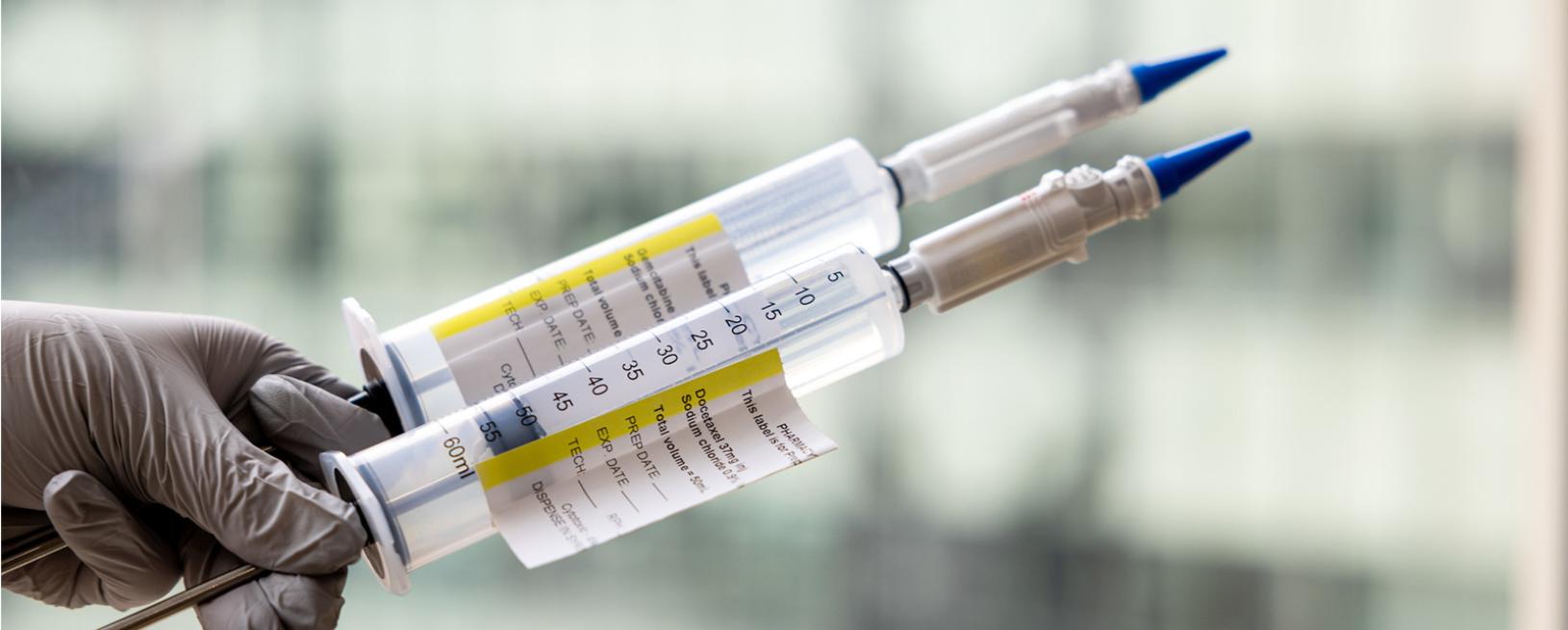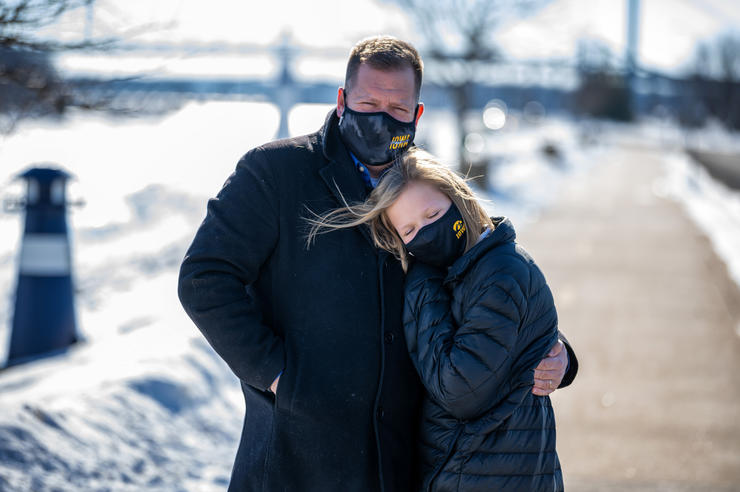Bladder cancer breakthrough

As a young investigator on the Harvard Medical School faculty in the 1990s, Michael O’Donnell, MD, began to question the conventional approach to treating early-stage bladder cancer.
The regimen for high-risk cases had remained the same since the 1970s: tumor resection followed by intravesical bacillus Calmette-Guerin (BCG), an immunotherapy derived from cow tuberculosis. Why BCG worked was not well understood, but it succeeded in about 60% of patients. For the rest, the only option left was radical cystectomy — removal of the bladder.
Bladder cancer is one of the most common cancers in the U.S. About 75% of patients are diagnosed with early-stage disease, known as superficial or non-muscle-invasive bladder cancer (NMIBC), which is usually highly treatable. The cancer cells are in the inner lining of the bladder but have not yet spread to the muscle layers.
Yet, as the millennium approached, O’Donnell saw that the chance of recurrence, progression, bladder removal, and death caused by this treatable disease hadn’t changed in more than 20 years. Investigations at that time typically focused on single-agent approaches that repeatedly proved less effective and more toxic than BCG.
Bladder cancer is the sixth most common cancer in Iowa. In men, it’s the fourth most common cancer in the U.S.
Estimates for 2024 (Iowa):
- New bladder cancer diagnoses: 950
- Bladder cancer deaths: 480
- Bladder cancer survivors: 8,125
Top risk factors:
- Smoking (causes about half of all cases)
- Workplace exposure to chemicals
- Gender (much more common in men)
- Age (much more common in people over 55)
Source: 2024 Cancer in Iowa Report; American Cancer Society
The field of study appeared to be stuck in a rut. O’Donnell was ready to try something different. In 2000, during a trip to the University of Iowa to deliver a lecture, O’Donnell received an intriguing offer from Richard Williams, MD, then chair of the UI Department of Urology: Come to Iowa and build a world-class bladder cancer program.
O’Donnell seized the opportunity to put his ideas into practice. He left Boston for Iowa City.
“The whole point is to cure as many cancers without removing bladders,” says O’Donnell, now the Richard D. Williams Professor of Urology and director of urologic oncology for UI Health Care. “It struck me as odd that in the rest of oncology, cancers were being treated with multi-agent chemotherapy, yet in urology we persisted in using single drugs and hoping that they would somehow miraculously give large effects. And it wasn’t happening.”
Success of multi-agent approach makes Iowa a destination for care
O’Donnell began studying chemotherapy combinations that could maximize efficacy while minimizing toxicity. Sticking to that approach over two decades, he has devised an astonishing six new intravesical chemotherapy treatments, giving urologists an unprecedented number of options to save bladders and keep patients cancer-free.
The centerpiece of that body of work is a regimen of sequential doses of two low-cost generics: gemcitabine and docetaxel (gem/doce). In 2015, O’Donnell and his UI colleagues published the first study of the therapy’s effectiveness. They described their success using gem/doce to treat 45 patients who had failed multiple courses of BCG. Two years after treatment, 34% of those patients — patients who otherwise would have been advised to have their bladders removed — were cancer-free.

Michael O’Donnell, MD
Urologists at leading cancer centers across the country, including Johns Hopkins, Harvard, and MD Anderson, were now turning to Iowa to learn about using gem/doce after BCG failures. At the same time, bladder cancer patients from around the world were traveling to UI Health Care Holden Comprehensive Cancer Center after learning about O’Donnell’s groundbreaking work.
As the UI program refined and improved the gem/doce regimen, O’Donnell began recommending the new therapy to most of his patients as a first-line therapy in place of BCG, which was often in short supply because of manufacturing problems. When BCG supplies went into a critical, long-term, worldwide shortage in 2019, the UI bladder cancer program weathered the disruption because it had already moved beyond sole reliance on BCG.
O’Donnell believes all programs should strive to do the same, and the UI program is paving the way for them.
“We have the most advanced early-stage bladder cancer program in the world,” he says.
“If you believe in the motto of this institution — Changing Medicine, Changing Lives — you have to put your money where your mouth is. Otherwise you’re just doing the same thing as everybody else. Who wants to be average?”
Studies show promise of new therapy
In 2022, a milestone study was published in the Journal of Urology that analyzed follow-up data from 107 patients with high-risk NMIBC who received gem/doce as first-line therapy, bypassing BCG altogether. It was the largest study ever conducted of such a population, and it reported that 82% of those patients remained cancer-free at two years, significantly higher than BCG’s two-year, cancer-free rate, historically about 60–65%.
The findings highlighted the promise of gem/doce as an effective replacement for BCG for high-risk disease. With BCG still nearly unobtainable for the foreseeable future, more and more urologic oncologists are looking to use gem/doce.
Also in 2022, a survey of urologic oncologists in North America found that 71% had prescribed gem/doce in the previous year for patients who had failed BCG. The authors of the article estimated that at least 1,300 NMIBC patients now receive the UI-pioneered regimen each year.
To date, all the studies reporting on gem/doce outcomes have been retrospective, analyzing past patient data, and most of that data has come from UI Health Care patients. A UI study directly comparing gem/doce to BCG, published in in JAMA Network Open in February 2023, was also a retrospective analysis of UI patient data, and it showed that gem/doce was better than BCG in preventing recurrence of high-risk cancer in a population of 312 patients. In early 2023, however, a group of cancer research centers launched the BRIDGE clinical trial, a highly anticipated nationwide study that will recruit 870 NMIBC patients and conduct the first prospective, controlled, randomized comparison of BCG and gem/doce.
The first step toward personalized bladder cancer care
Although the BRIDGE trial likely won’t be completed for six or seven years, UI Health Care is ready now to start moving bladder cancer care into its next era.
Researchers will be continuing the UI’s early work to personalize NMIBC care through genomics.
Biomarkers in the urine, blood, or the tumor can help predict if a patient is going to respond better to a particular treatment. The UI has a large repository of tissue and blood samples from patient volunteers that are used by researchers.
With multiple treatments available, patients will receive better care if their doctors know in advance which therapy will likely work best for them.
(items in bold = developed at University of Iowa Health Care by Michael O’Donnell, MD, and colleagues)
1961: Thiotepa
1967: Mitomycin C
1976: BCG
1977: Adriamycin
1986: Epirubicin
1990: Interferon
1996: BCG + Interferon
1997: Valrubicin
2002: Gemcitabine
2006: Docetaxel
2006: Gemcitabine / Mitomycin
2015: Gemcitabine / Docetaxel
2017: Quad Immuno BCG (BCG, Interferon, Interlukin-2, Granulocyte-Macrophage Colony-Stimulating Factor)
2018: Quad Chemo (Adriamycin-Gemcitabine Mitomycin-Docetaxel)
2020: Gemcitabine / Cabazitaxel /Cisplat
2022: Gemcitabine /Cabazitaxel/Pembro
2022: Valrubicin / Docetaxel
A program — and a career — defined by reimagining what’s possible
As O’Donnell surveys the bladder cancer program that Williams challenged him to build, he sees it on a trajectory even he couldn’t have imagined back in 2000.
“This is what you want your career to turn into,” he says. “You want it to take on a life of its own.”
To illustrate the driving force that led to that, O’Donnell recalls a conversation that could have been lifted straight from the script of a TV medical melodrama.
In 2013, he had run out of options for a patient who had a small tumor in his bladder. The best available treatments — including gem/doce — had failed to kill the cancer cells. The only realistic choice left was radical cystectomy.
The patient refused.
“He wanted a better choice,” O’Donnell says. “He looked me in the eye and said, ‘I have a tumor the size of a postage stamp, and you’re telling me I have to lose my bladder? No. Come up with something else.’”
To most ears, that might have sounded like an unreasonable demand. For O’Donnell, it was a rallying cry.
“A lot of the work I do is the direct result of heroic patients who stood up for what they believed in and put their trust in me to try something new,” he says.
O’Donnell responded by devising another novel intravesical chemotherapy combination — valrubicin and docetaxel — that, to his knowledge, had never been used to treat NMIBC.
It worked. The patient kept his bladder and a year later was cancer-free. O’Donnell has since used that regimen to treat dozens of patients who otherwise would have had no choice but to opt for a cystectomy.
With that kind of inspiration, along with the generosity of the John and Carol Walter Family Foundation and other donors who support his program’s research, O’Donnell considers it his duty to keep pushing against the boundaries of what is possible.
“If you believe in the motto of this institution — ‘Changing Medicine, Changing Lives’ — you have to put your money where your mouth is,” O’Donnell says. “Otherwise, you’re just doing the same thing as everybody else. Who wants to be average?”
The urology experts at University of Iowa Health Care provide comprehensive evaluation and treatment in the clinic setting as well as surgical interventions for all urologic system diseases and disorders.


